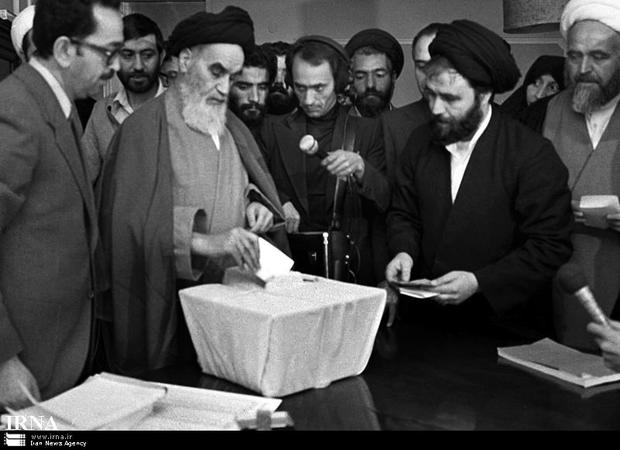- News code: 1238005
- Source: en.imam-khomeini.ir
The Imam tried hard to make people aware of the importance of a referendum, which appointed the type of government people wanted and announced their opinion with regards to an Islamic republic. He frequently repeated the following in his speeches: "You are free to vote for anything you want. I myself will vote for an Islamic Republic."
Finally on Friday the 30th of March 1979 the people voted. The leader of the revolution voted during the early hours of the day. The polls showed that 98% of the people voted for an Islamic republic.
On the 1st of April the Imam congratulated the people for their choice and officially announced the establishment of an Islamic republic. Four days later the Imam formed a constitutional assembly in order for the constitutional laws to be discussed and approved.
Other measures the Imam took were: to order a committee to be formed to help those in need and to open up a bank account with the number 100 as the account number. This account was for those who needed homes and shelters.
 Tehran- Jamaran; the Imam voting
Tehran- Jamaran; the Imam votingOn the 25th of May Imam Khomeini assigned Bazargan, the provisional Prime Minister, the job of perfecting the constitutional laws. The revolutionary council had to approve it and the different sects of people, who were represented by different ministers, had to approve the laws and give their views regarding it.
On the 3rd of August millions of Iranian all over the country came to vote for the ministers of parliament. Seventy five ministers were chosen by the people. These ministers had the responsibility of discussing and approving the constitutional laws.
The simultaneous efforts of the Pahlavi regime's fallen elements, the
 Tehran- Jamaran; the Imam voting
Tehran- Jamaran; the Imam votinginformation services and the security councils of America, Israel and the Soviet Union and some political parties opposing the revolution, were known as the main obstacles in getting the country back to normality. What made Imam Khomeini's work more
difficult were the cries for independence from the cities on the border, tribal disputes, and the assassination of great characters who played great roles in the revolution such as: Vali Allah Qarani, Ayatollah Motahari, Ayatollah Mofateh, Mehdi Araqi, and Hashemi Rafsanjani. Imam Khomeini always tried to keep a good relationship with the people by telling them of all the daily occurrences. This is because he believed that the people are what hold the country and the revolution together. The following events showed that Imam Khomeini's strategies were vital in helping the revolution successfully pass the first few shaky years.
On the 6th of September 1979, the provisional Prime Minister announced that in order to observe the country's affairs and create harmony in the government, the Imam should travel to Tehran. However Imam Khomeini stated that if he came to Tehran it would prevent him from his daily work and thinking about future strategies. Therefore, the provisional Prime Minister found the circumstances too difficult and so after the conquering of the American embassy in Tehran, he resigned. Imam Khomeini transferred his responsibilities to the revolutionary council. Due to various pressures and difficulties the Imam had a heart attack on the 22nd of January 1980 and was transferred to a hospital in Tehran.
- The Imam's Background
- The childhood period
- Immigration to Arak
- Immigration to Qom
- Marital life
- Imam from 1941-1961
- The start of political confrontations
- The attack on Faydhiah School
- Exile to Turkey
- Exile to Iraq
- Exile to Paris
- Return to Tehran
- Visiting the holy city of Qom
- Establishment of an Islamic Republic
- Residence in Tehran
- Death (1989)

